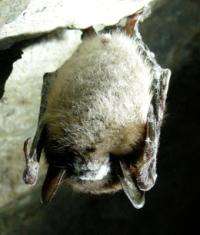Unlocking the mystery of the disappearing bats

A McMaster researcher is working to pull one of North America's most common bats back from the brink of extinction.
Jianping Xu, an associate professor of biology and member of the Institute for Infectious Disease Research, is collaborating with leading microbiologists across the continent to better understand the Geomyces destructans fungal disease, better known as white-nose syndrome. The fungus grows on the bats' skin while they hibernate, causing them to wake up and deplete their deposits of fat prematurely. The infection eventually kills them.
First discovered in 2006 in caves and mines around Albany, New York, the fungus, thought to have already killed more than one million bats, is now rampant throughout the northeastern U.S., Ontario and Quebec. Research indicates that at the current rate of infection, the little brown bat could be nearly extinct in less than 20 years.
To understand the fungus, its origin and spread, researchers analyzed the DNA of 16 strains from caves in seven New York counties and one from Vermont. They then compared Geomyces destructans with a closely related species called Geomyces panoma and found that all the Geomyces destructans strains were genetically identical. This led them to believe that white-nose syndrome in northeastern North America is caused by a single strain that has undergone rapid dispersal to cause all of the bat deaths, from New York to Tennessee and from Oklahoma to Quebec.
"While the exact cause of death is still unknown, one of the things scientists have identified is that the fungus can disrupt the tissue membrane in a whim and that makes them unable to fly effectively," said Xu. "It also makes them lose circulation, water and the mechanism to regulate body temperature."
Researchers have discovered a treatment that could help preserve the species. They tested the response of six strains of the fungus to drugs already used to treat people and animals for ailments ranging from athlete's foot to life-threatening infections. The drugs include fluconazole, the most widely used antifungal drug. The fungus was found to be susceptible to all of the drugs.
Xu said researchers are working quickly to understand white-nose syndrome before it's too late.
"While bats are carriers of certain disease, including rabies, the loss of the bat population would be detrimental," he said. "There would be serious consequences: first, many plants require bats for pollination, and second, bats are predators for insects such as flies and mosquitoes, and many of those insects are vectors for human disease like West Nile and malaria. If these bats are gone there would be no natural predator, so we would probably experience an increase in insect-borne infectious diseases."
Researchers have made headway, but little else is known about the fungus.
"Scientists do not know how the fungus affects bats at the cellular and molecular level or even how it reproduces in nature or in bats themselves," said Xu. "But by having the opportunity to collaborate on an international scale with researchers looking at fungal population biology and epidemiology, scientists can work quickly to understand the fungus. There are no boundaries to understanding disease when you have a global perspective."
The findings appear in the journal Emerging Infectious Diseases.
More information: DOI: 10.3201/eid1707.102056
Provided by McMaster University
















